
Notolabrus fucicola, the banded parrotfish, blue wrasse, kelpie, New Zealand banded wrasse, purple parrotfish, saddled wrasse, Southern purple wrasse, Southern wrasse, winter bream or yellow-saddled wrasse, is a species of wrasse native to the eastern Indian Ocean, off eastern Australia and all around New Zealand on rocky, weedy reef areas. Aging work in New Zealand suggested these wrasses can live at least 35 years.

The slippery dick is a species of wrasse native to shallow, tropical waters of the western Atlantic Ocean.
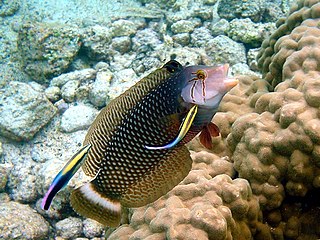
Novaculichthys taeniourus, also known as the rockmover wrasse, carpet wrasse, dragon wrasse, bar-cheeked wrasse, olive-scribbled wrasse or reindeer wrasse, is a species of wrasse mainly found in coral reefs and lagoons in the Indo-Pacific region. These include habitats in the Gulf of California to Panama; tropical Pacific Ocean islands including Hawaii; the Philippines, Indonesia and Australia; and the Indian Ocean to the east coast of Africa. The common name, "rockmover wrasse", comes from their behavior of upending small stones and reef fragments in search of prey. This species is the only known member of its genus.

The blueside wrasse, Cirrhilabrus cyanopleura, is a species of wrasse native to the eastern Indian Ocean and the western Pacific Ocean. It is found on reefs in schools swimming 1 to 2 m above the bottom. It occurs at depths from 2 to 30 m, most often between 5 and 20 m. This species can reach a standard length of 15 cm (5.9 in). It can be found in the aquarium trade.
Cirrhilabrus ryukyuensis is a wrasse from the western Pacific Ocean from Indonesia, Malaysia and the Philippines north to Japan. It occasionally makes its way into the aquarium trade. It grows to a size of 15 cm in length. SOme authorities regard this taxon as a synonym of Cirrhilabrus cyanopleura, but Fishbase and the Catalog of Fishes treat it as a valid species. This species was called Cirrhilabrus lyukyuensis but this is treated as a misspelling.

The striated wrasse, also known as the disappearing wrasse, pinstripe wrasse or scarlet wrasse, is a species of marine ray-finned fish from the family Labridae, the wrasses. It has a wide Indo-Pacific distribution. This species can also be found in the aquarium trade.
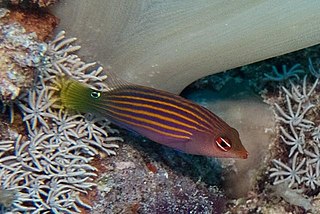
The six-line wrasse is a species of marine ray-finned fish from the family Labridae which has a wide Indo-Pacific distribution. This species is associated with coral reefs and can be found in the aquarium trade.
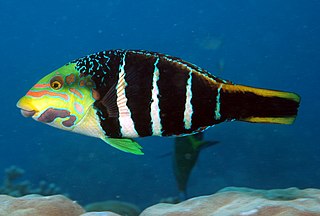
The barred thicklip wrasse, Hemigymnus fasciatus, is a species of fish belonging to the wrasse family, native from the Indo-Pacific.

The western blue groper is a species of wrasse native to coastal waters of southern Australia from the Houtman Abrolhos in Western Australia to west of Melbourne.

The yellowhead wrasse is a fish species belonging to wrasse family native to shallow tropical waters in the Caribbean Sea and western Atlantic Ocean.
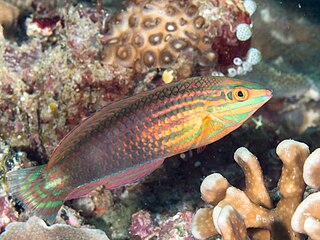
The red-lined wrasse, two-spotted wrasse or biocellated wrasse, Halichoeres biocellatus, is a species of wrasse native to shallow tropical waters in the western Pacific Ocean.

The creole wrasse is a species of wrasse native to the western Atlantic Ocean.

The chiseltooth wrasse is a species of marine ray-finned fish, a wrasse from the family Labridae. It is native to the Indian Ocean and the western Pacific Ocean. It is an inhabitant of coral reefs and can be found at depths from 3 to 60 m, though rarely deeper than 40 m (130 ft). This species grows to 30 cm (12 in) in total length. It is of minor importance to local commercial fisheries and can be found in the aquarium trade. P. moluccanus is the only known member of its genus.

Halichoeres maculipinna, the clown wrasse, is a species of tropical fish that lives throughout the Caribbean Sea and adjacent parts of the western Atlantic Ocean. It is a carnivorous, multi-colored wrasse that is common throughout its range.
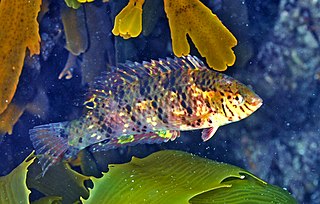
Dotalabrus aurantiacus, Castelnau's wrasse, is a species of wrasses native to the Indian Ocean coasts of Australia. It is the type species of its genus. The type locality is Adelaide, St. Vincent Gulf, South Australia.

Notolabrus gymnogenis, commonly known as the crimson banded wrasse, is a species of fish in the family Labridae. This colourful fish is endemic to Eastern Australia.

Pseudolabrus guentheri, or Gunther's wrasse, is a ray-finned fish from the wrasse family. It was named for Albert Günther.

The brownspotted wrasse, also known as the blue-spotted parrotfish, brown-spotted parrotfish and orangespotted wrasse, is a species of marine ray-finned fish from the family Labridae, the wrasses. It is found in the Indian Ocean off the western and southern coasts of Australia.
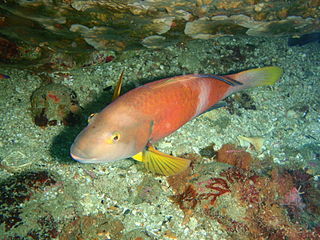
The blue-throated wrasse, also known as the bluehead, bluehead parrotfish, bluenose, bluenose parrotfish, bluethroat parrotfish, blue-throat wrasse, kelpie, lilac banded parrotfish, rocky bream, rocky cod, rotfish or winter bream, is a species of marine ray-finned fish from the family Labridae, the wrasses. It is found in the Indian and Pacific Ocean off the south-eastern coasts of Australia.

Stethojulis strigiventer, also known as the three-ribbon wrasse, silverstreak wrasse, silverbelly wrasse, lined rainbowfish or silver-streaked rainbowfish, is a species of marine ray-finned fish, a wrasse from the family Labridae. This species occurs in beds of seagrass and areas of inner reefs and shallow lagoons where there is a substrate consisting of mixed sand, rubble, and algae. It is found in small groups which swim over large areas down as deep as 20 metres (66 ft). The range of this species extends from the Red Sea southwards along the eastern coast of Africa to Algoa Bay in KwaZulu-Natal, South Africa and eastwards to the Marshall and Tuamotu islands, it also extends north to Honshu and south to New South Wales. This species was first formally described as Julis strigiventer in 1833 by the English zoologist Edward Turner Bennett (1797-1836) with the type locality given as Mauritius. When Albert Günther created the genus Stethojulis he designated Julis strigiventer as the type species.




















